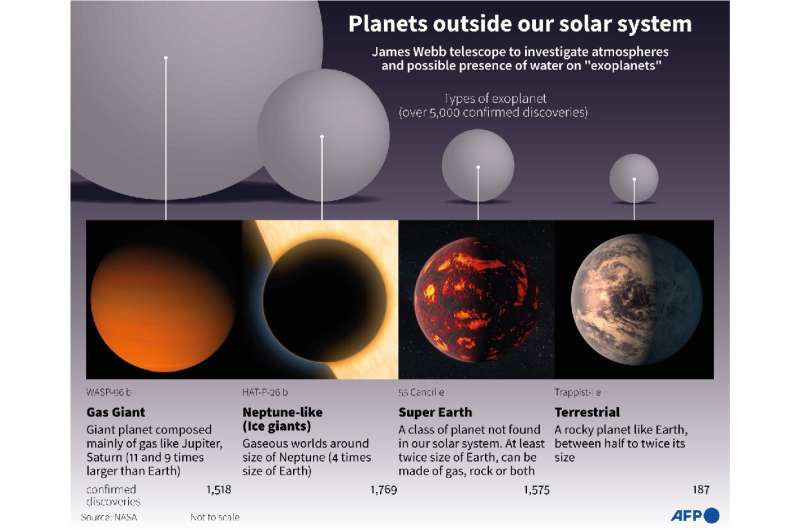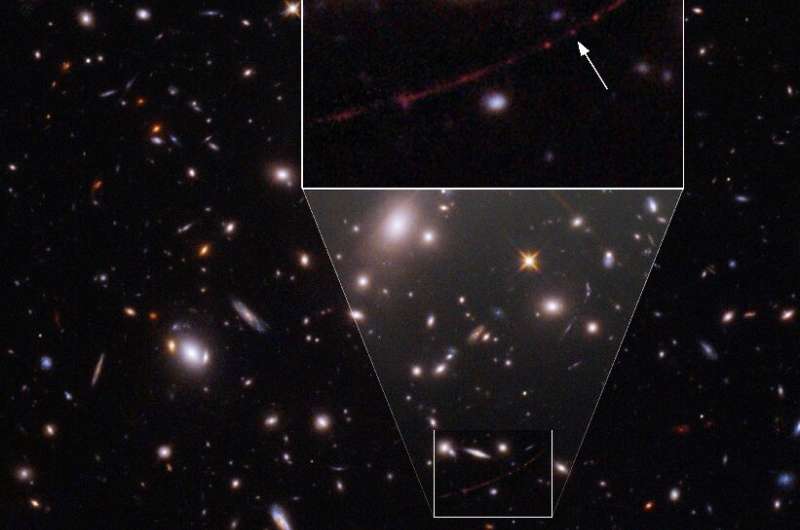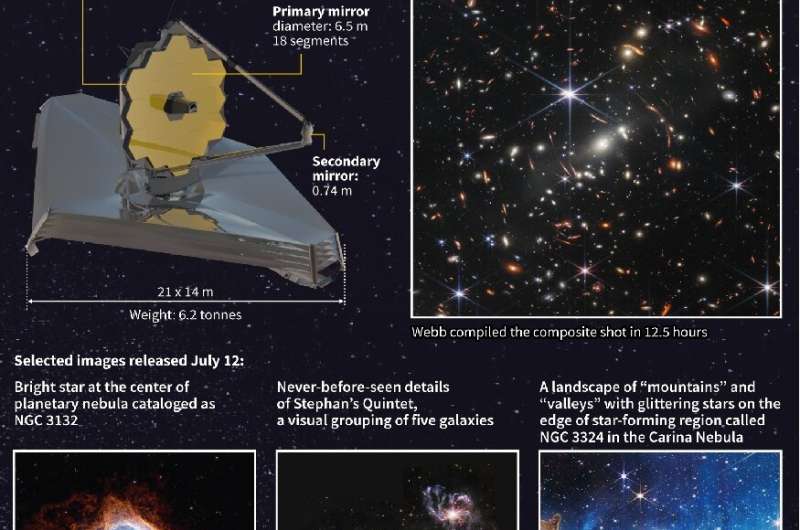 Graphic on the different types of "exoplanets" which the new James Webb telescope will be investigating to determine the composition of their atmospheres and the presence of water.
Graphic on the different types of "exoplanets" which the new James Webb telescope will be investigating to determine the composition of their atmospheres and the presence of water. Posted on 07/14/2022 4:05:41 PM PDT by LibWhacker
 Graphic on the different types of "exoplanets" which the new James Webb telescope will be investigating to determine the composition of their atmospheres and the presence of water.
Graphic on the different types of "exoplanets" which the new James Webb telescope will be investigating to determine the composition of their atmospheres and the presence of water.
The first stunning images from the James Webb Space Telescope were revealed this week, but its journey of cosmic discovery has only just begun.
Here is a look at two early projects that will take advantage of the orbiting observatory's powerful instruments.
The first stars and galaxies
One of the great promises of the telescope is its ability to study the earliest phase of cosmic history, shortly after the Big Bang 13.8 billion years ago.
The more distant objects are from us, the longer it takes for their light to reach us, and so to gaze back into the distant universe is to look back in the deep past.
"We're going to look back into that earliest time to see the first galaxies that formed in the history of the universe," explained Space Telescope Science Institute astronomer Dan Coe, who specializes in the early universe.
Astronomers have so far gone back 97 percent of the way back to the Big Bang, but "we just see these tiny red specks when we look at these galaxies that are so far away."
"With Webb, we'll finally be able to see inside these galaxies and see what they're made of."
While today's galaxies are shaped like spirals or ellipticals, the earliest building blocks were "clumpy and irregular," and Webb should reveal older redder stars in them, more like our Sun, that were invisible to the Hubble Space Telescope.
Coe has two Webb projects coming up—observing one of the most distant galaxies known, MACS0647-JD, which he found in 2013, and Earendel, the most distant star ever detected, which was found in March of this year.
 Webb will turn its instruments on distant stars like Earendel, seen in here in an image taken by Hubble.
Webb will turn its instruments on distant stars like Earendel, seen in here in an image taken by Hubble.
While the public has been enticed by Webb's stunning pictures, which are shot in infrared because light from the far cosmos has stretched into these wavelengths as the universe expanded, scientists are equally keen on spectroscopy.
Analyzing the light spectrum of an object reveals its properties, including temperature, mass, and chemical composition—effectively, forensic science for astronomy.
Science doesn't yet know what the earliest stars, which probably started forming 100 million years after the Big Bang, will look like.
"We might see things that are very different," said Coe—so-called "Population III" stars that are theorized to have been much more massive than our own Sun, and "pristine," meaning they were made up solely of hydrogen and helium.
These eventually exploded in supernovae, contributing to the cosmic chemical enrichment that created the stars and planets we see today.
Some are doubtful these pristine Population III stars will ever be found—but that won't stop the astronomical community from trying.
Anyone out there?
Astronomers won time on Webb based on a competitive selection process, open to all regardless of how advanced they are in their careers.
 Graphic on the James Webb space telescope. which began releasing a new wave of cosmic images.
Graphic on the James Webb space telescope. which began releasing a new wave of cosmic images.
Olivia Lim, a doctoral student at the University of Montreal, is only 25 years old. "I was not even born when people started talking about this telescope," she told AFP.
Her goal: to observe the roughly Earth-sized rocky planets revolving around a star named Trappist-1. They are so close to each other that from the surface of one, you could see the others appearing clearly in the sky.
"The Trappist-1 system is unique," explains Lim. "Almost all of the conditions there are favorable for the search for life outside our solar system."
In addition, three of Trappist-1's seven planets are in the Goldilocks "habitable zone," neither too close nor too far from their star, permitting the right temperatures for liquid water to exist on their surface.
The system is "only" 39 light year away—and we can see the planets transit in front of their star.
This makes it possible to observe the drop in luminosity that crossing the star produces, and use spectroscopy to infer planetary properties.
It's not yet known if these planets have an atmosphere, but that's what Lim is looking to find out. If so, the light passing through these atmospheres will be "filtered" through the molecules it contains, leaving signatures for Webb.
The jackpot for her would be to detect the presence of water vapor, carbon dioxide and ozone.
Trappist-1 is such a prime target that several other science teams have also been granted time to observe them.
Finding traces of life there, if they exist, will still take time, according to Lim. But "everything we're doing this year are really important steps to get to that ultimate goal."
Are they looking in our Galaxy and not galaxies a long time ago and far far away
These scientists sound so foolish when they say the big bang occurred 13 billion years ago. The furthest lights are 13+ billion light years away, so they assume the galaxy is 13+ billion years old. To get that, you have to assume:
1. that galaxies travels at or near the speed of light. They don’t, so it may have taken them long to get to where they are, or were when the light we see started.
2 You have assume we are at the center of the universe, since we can see galaxies at that distance in all directions.
How can we assume light from the furthest seen galaxy to our west hasn’t reached the furthest seen galaxy to the east? That would make the universe at least 26+ billion light years wide.
Looking for nuclear radiation.......?
My guess is that they’ll concentrate on the Milky Way first. Plenty of pickings there!
“The furthest lights are 13+ billion light years away, so they assume the galaxy is 13+ billion years old. To get that, you have to assume:
1. that galaxies travels at or near the speed of light. They don’t, so it may have taken them long to get to where they are, or were when the light we see started.
2 You have assume we are at the center of the universe, since we can see galaxies at that distance in all directions.”
Your ignorance of astronomy and the age of the universe is astounding.
The Big Bang THEORY. How did everything we know at present begin? Scientist THINK it began 13.8 billion years ago, and some THINK it started with a BIG BANG. I haven’t seen any of those ”scientists “ expound on where the matter, or the energy came from, andwhat “triggered” the BANG. There is a lot more unknown than known.
Thanks LibWhacker.
· join · view topics · view or post blog · bookmark ·
· post new topic · subscribe ·Google news searches: exoplanet · exosolar · extrasolar ·
“How can we assume light from the furthest seen galaxy to our west hasn’t reached the furthest seen galaxy to the east? That would make the universe at least 26+ billion light years wide.”
You might start your education by researching Hubble Constant and CMB.
“I haven’t seen any of those ”scientists “ expound on where the matter, or the energy came from, andwhat “triggered” the BANG. “
They have. Do your homework.
“That would make the universe at least 26+ billion light years wide.”
93 BILLION LIGHT YEARS
“Scientist THINK it began 13.8 billion years ago,”
Scientist calculated it began 13.8 billion years ago,
I recently read that within a few seconds of the Big Bang the universe was already 20 or 30 light years across. And in that hyper-expansion, it carried all the objects embedded in it along for the ride. Those ojects were not moving through space faster than light. They were moving with space. And Einstein has nothing to say about how fast space can expand.
That changes everything in your calculations, and mine. Apparently (I don't claim to understand it), because of this hyper-expansion of space, the universe itself may be much larger than 26 billion light years across.
Hundreds of billions? Maybe. Infinitely large? I've even read that, though I don't see how that's possible!
“1. that galaxies travels at or near the speed of light. They don’t, so it may have taken them long to get to where they are, or were when the light we see started.”
The most distant galaxies are traveling away from us faster than the speed of light.
Just think how far light will travel in one year. It's mind-boggling.
Mind-boggling like this:
(from 7 years ago)
NASA Discovers A Super-Distant Galaxy That's 300 Trillion Times Brighter Than The Sun
Lawyer: “Ok, why don’t you start at the beginning”.
Witness: “Well, about 2 billion years ago the earth’s surface cooled a crust formed.”
Lawyer “Maybe not that long ago...”
So, Tex, Tell me again the one-way speed of light? Einstein couldn’t nor wouldn’t try. He understood that we can only derive a round trip SOL, so knowing just how light acts in reality, is, well, beyond us. A convention agreed upon because knowing, not just assuming, is not possible given both technology and constraint. All of the facets of physics simply tell us, “whoa, there fella, my secrets are mine”.
“In the Beginning (of time)... God said, “let there be light, and light was””. Ought to make us think about light in a different, well, light.
And, to those who will say it has to be uniform, the correct answer is no, it only has to be seen as consistent from application to application, and observation to observation.
Most of astronomy has passed from observation to supposition and assumption; and, heaven help us, consensus.
But I defer to those who spend much more time on the subject, as to breadth of training and assumption, not truth, necessarily.
“2 You have assume we are at the center of the universe, since we can see galaxies at that distance in all directions.”
Exactly opposite. It is assumed that the universe has no “center”.
How can they tell if it’s an Class M planet?
There is also this theory about it all being started by God.
Disclaimer: Opinions posted on Free Republic are those of the individual posters and do not necessarily represent the opinion of Free Republic or its management. All materials posted herein are protected by copyright law and the exemption for fair use of copyrighted works.